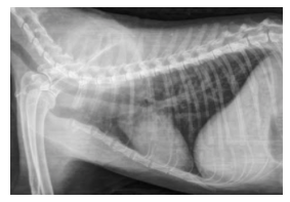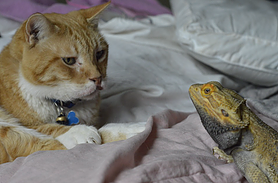by Lodi Vet | Mar 9, 2017 | Cats, Educational Materials
Asthma is a recurrent respiratory condition caused by inflammation and narrowing of the airways. Symptoms include wheezing, airway spasms, coughing, exercise intolerance and open mouthed or labored breathing. Approximately one out of every 100 cats will develop asthma. Age of onset is typically between 2 and 8 years of age. Siamese and Himalayan cats have an increased prevalence of asthma.
Diagnosing asthma involves combining the history, physical exam findings, radiographic findings, and ruling out other common causes of cough in cats. Several other conditions that cause coughing in cats need to be ruled out before starting treatment for asthma. Depending on the severity and type of symptoms noted the following tests may be needed to make the final diagnosis.
- Thoracic radiographs/chest x rays – may show over inflated lungs or thickened/inflamed airways in cats with asthma. Radiographs also allow measurement of the heart and evaluation of blood vessels in the chest.
- Heartworm testing – mosquitos can spread heartworm to any cat, even those strictly indoors. Many cats with heartworm disease have similar symptoms to cats with asthma.
- ProBNP – A blood test is available that helps determine the stretch or stress on the heart muscle and can be helpful in distinguishing an asthmatic cough from a heart related cough.
- Parasite testing – some species of worms travel through the lungs during parts of their lifestages (ex: roundworms), other worms prefer to reside in the lungs (ex: lungworms). Stool testing can be performed to look for evidence of parasites.
- Medical work up –additional blood testing is available to check organ function and red and white blood cell counts. This may be needed to help determine if a cat is healthy in other regards, prior to starting medication to control asthma symptoms.
- Tracheal wash or bronchoalveolar lavage – advanced testing may be warranted in some cases. These tests allow for cells from the airways to be analyzed and allows infectious disease tests to be performed on the airway secretions.

Radiograph of a cat with asthma
Treatment is aimed at reducing inflammation of the airways.
Each asthmatic cat will require a treatment protocol that works best at controlling their symptoms while reducing long term side effects of the medications needed. The following are different therapies available for the treatment of asthma in cats. Some cats need only one medication, whereas others require a combination of drugs.
- Steroids –reduce inflammation of the airways. Side effects can include: increased thirst, increased urination, increased hunger, and long term use can sometimes cause elevated liver enzymes, diabetes or pancreatitis.
- Dewormer – may be given to treat for parasites as a component of cough
- Antibiotics – may be given to treat infection as a component of cough
- Bronchodialators – are administered to help open up the airways.
- Antihistamines- reduce allergic response in the airways.
- Cerenia – off label use of an oral anti-nausea drug for dogs. This medication has been found to be helpful in reducing inflammation of the airways with infrequent dosing and minimal side effects.
- Inhalers – can be used to help reduce inflammation and spasming of the airways. A specific dosing chamber is needed to help cats inhale the medication. See: https://www.trudellmed.com/animal-health/aerokat
Environmental control can be helpful in reducing asthma symptoms in cats.
Unscented dustless cat litter – such as Yesterday’s News or Dr. Elsey’s Precious Cat Ultra 99.9% dust free litter
- HEPA filters can reduce aerosolized allergens
- No smoking – second hand cigarette smoke can significantly increase asthma symptoms in cats
- No aerosol sprays, perfumed detergents, scented carpet cleaners or powders
- Use perfume free laundry detergent (ex: Tide Free or All Free n Clear)
Monitoring is needed to tailor treatments for each cat:
The goal is to use the right combination of therapies for each pet based on the severity and symptoms of their asthma. Repeat exams, radiographs and close communication between pet owner and veterinarian are needed to tailor the best asthma treatment. If at any time you are worried about your pets breathing, call our emergency number 608-592-3232.
by Lodi Vet | Jan 23, 2017 | Dogs, How To, Obedience Training
Using a travel kennel for your brand new puppy will prove invaluable. The puppy will look at the crate as a bed area which will aid in housetraining. The crate will also provide a safe place where your puppy will be unable to eat or chew unwanted items. When using treats for training, each puppy will vary. Some puppies will be happy to work for puppy food, while others may need something special such as Cheerios or a very smelly, rich treat such as freeze dried liver or hotdogs. Rich treats should be the size of a pencil eraser.
You may be able to split meals into 4 portions and use these portions for training purposes. Steps to help your puppy adjust to the crate: This should be started as soon as the puppy comes home.
1. Choose a quiet place for the crate.
(Remember this will be like your puppy’s bedroom). Having a crate in your bedroom will help you hear the puppy in the middle of the night if a bathroom break is necessary.
- Keep the crate small enough for the puppy to only sleep in.
- Keep food and water out of the kennel.
- Try a soft blanket, towel, or bed but watch carefully for any signs of chewing, and remove items to prevent the puppy from swallowing anything that would need to be surgically removed.
- Have a chew toy or interactive toy which the puppy can not destroy such as a nylabone or kong.
- Some people have had success placing something warm in the crate for the puppy to snuggle up to. Be very careful since all puppies can chew aggressively.
2. Teaching your puppy
Quiet in the kennel can begin the first day you bring the puppy home.
- Make sure your puppy has urinated and defecated before going in the crate.
- Introduce the crate by tossing treats in the crate and allowing the puppy to get the treat and come back out. There is no need to praise the puppy for coming out of the kennel. Continue this process until the puppy stops coming out of the kennel and waits for more treats. This is the time to sprinkle treats over the floor of the kennel and shut the door.
- While your puppy is eating the treats, step out of sight. If you can count to ten and the puppy is quiet, stuff a treat in the door, open the door, and walk away. Let your puppy stay in the kennel if sleeping.
- After a five – ten minute break, place your puppy in the kennel, close the door, and step out of sight. Wait 10 seconds, before rewarding a quiet puppy and opening the door. Keep this process up by steadily increasing the quiet time by 10 second increments before letting the puppy out. As long as the puppy is quiet with the door shut, keep giving rewards after the lengthened time.
- If your puppy starts howling or whining in the kennel, bump the kennel and say “Quiet”. As soon as the puppy stops vocalizing, poke a treat through the door, and open the door.
- Five minutes later, put the puppy back in the kennel and wait for the count of 10. If the puppy starts howling at any time, bump the kennel and say Quiet, then start counting to 10. Keep repeating the bump and Quiet until the puppy is quiet and you can count to 10. Give a treat and open the door.
- You will repeat this process until your puppy will be quiet for 1 minute. Most puppies will fall asleep by this time. Let them sleep.
- This training session should happen three times an hour.
- Never reward a puppy that is climbing on the door or whining.
3. Eventually your puppy will need to sleep in their kennel.
All puppies will cry for a time when they realize they are alone.
- You can help your puppy adjust to their bed area by placing them in the kennel whenever they get sleepy or scheduling regular time outs for naps.
- Have your puppy get used to being on their own. Do not carry them wherever you go, or hold them on your lap while awake and keep them out of your bed.
by Lodi Vet | Jan 23, 2017 | Cats, Dogs, Educational Materials
 Salmonella is a type of bacteria that can cause disease in humans, and can be particularly dangerous to young children and infants, the elderly, and adults with immune system problems.
Salmonella is a type of bacteria that can cause disease in humans, and can be particularly dangerous to young children and infants, the elderly, and adults with immune system problems.
Healthy reptiles may host a variety of Salmonella species of bacteria in their intestinal tracts. They may shed the organism in the stool from time to time, and show no physical symptoms. Salmonella can be cultured from the stool during periods of active shedding, but even if the stool culture is negative, this does not guarantee that the animal will not shed the organism in the future. Also, Salmonella can persist in the environment for a long time if proper disinfection is not carried out.
Antibiotics are not effective and reliable for Salmonella infections in reptiles. In fact, antibiotic use can actually result in the development of strains of bacteria that are resistant to antibiotics. Animals that are positive for Salmonella are a serious public health risk.
**To totally eliminate the risk of Salmonella, the only option is to not keep reptiles**
Owners who choose to keep reptiles should assume that Salmonella might be present and follow these guidelines:
- Never eat, drink, or put anything in your mouth when working with reptiles.
- Wash hands with hot water and antibacterial soap after handling reptiles.
- Wash all cages and cage furnishings in hot soapy water, then disinfect with household bleach (one cup in a gallon of water). Contact time should be at least 30 seconds. Rinse thoroughly.
- Clean cages frequently and thoroughly. Remove uneaten food and wash bowls daily.
- Do not clean cages or wash bowls in sinks or tubs that are used by people. When cleaning cages, pour waste water down the toilet.
- Confine reptiles to a cage. Children, the elderly and immune-compromised individuals should not handle reptiles.
- Sick or dead animals should be examined by a veterinarian to determine if Salmonella is present.


